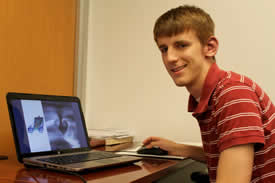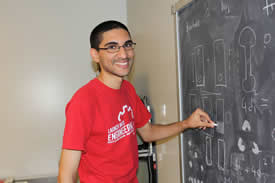Students from the University of Houston Cullen College of Engineering spent their summer conducting research as part of the 2011 Summer Undergraduate Research Fellowship (SURF) program. The fellowship provides funding for sophomores, juniors and seniors in any major to experience hands-on research on a full-time basis for 10 weeks.
“Undergraduate research really allows students to take the lead in their own education,” says Karen Weber, director of the UH Office of Undergraduate Research. “They are given a problem that has never been solved and, with the guidance of a faculty mentor, asked to work toward a solution. Going through this sort of experience makes students better able to ask and solve the important questions they encounter during the rest of their time at UH and beyond.”
Several engineering students participated in a wide range of research projects, from nanowire fabrication to attention span testing. Among the group was Dustin King, a mechanical engineering senior, who worked with Professor Fazle Hussain to study the stability of vortices that trail airplanes upon take-off. Computer simulations of these rotating air columns allowed Dustin to see how long they last, and subsequently, how long they prevent other planes from taking off right after.
“We are trying to find ways to reduce the length of time that trailing vortices last to make air traffic more efficient,” says Dustin. “Air traffic is projected to triple by 2025, and we have to find methods to make the vortex dissipate faster now.” Not only will Dustin's research in vortex stability help address problems with air traffic congestion, but it may also impact the efficiency of wind energy farms as well.
Tracy Ngu worked under the mentorship of Professor Navin Varadarajan on research of protein identification secreted from single cells using bead-bound antibodies. “The method of bead-bound antibodies for protein identification is a more effective way of identifying proteins compared to the current method of microengraving,” Tracy says. “Identifying proteins secreted from a single cell will help us understand immune responses at a cellular level, which will then help us improve treatments of diseases such as cancer and arthritis.” Tracy, who is a senior chemical engineering major, first learned about biology-based research techniques this summer. “Professor Varadarajan saw that I was very motivated to learn, even though my background is not in biology,” Tracy says.
In ongoing collaboration with Professor Li Sun, Christopher Ortega has been working on the design and fabrication of nanowires to enhance MRI contrast agents. “With MRIs, sometimes you don’t get a clear resolution, so there are contrast agents to differentiate between internal body structures like bone and muscle,” says Christopher, a senior mechanical engineering major. He is examining the development of nanowires, which have magnetic properties that allow for a higher contrast agent due to their controlled geometry. “We’re experimentalists,” Christopher notes. “We take an idea and look at the research others have done with that idea. Professor Sun develops a theory, and gives it to me to figure out how to make it work.”
Hamza Hallal is a junior mechanical engineering major who conducted research with Professor Haluk Ogmen. He developed a test that was based on research done in 1994 that analyzed the differences in shifting attention span between object-based and location-based systems using reaction time techniques.
“The ultimate goal with this research is to reverse-engineer the brain, that is, to create a computer that works exactly like a brain,” Hamza says. While the original experiment involved static stimuli, Hamza’s test built upon that premise and used dynamic stimuli to determine if the results stayed the same.

